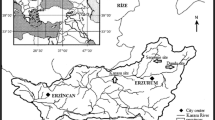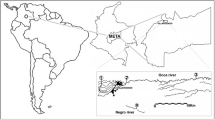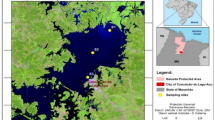Abstract
Genotoxic and hematological parameters in tambaqui (Colossoma macropomum), a native freshwater fish, were used as biomarkers to assess exposure to environmental stressors within the Maracanã Protected Area of Maranhão State, Brazil. Fish were sampled at two sites—Serena Lagoon (control) and Ambude River—on four occasions (dry and rainy season), and biometric data (length and weight) recorded and blood collected from all fish for analysis. Erythrocyte indices—mean corpuscular volume, mean corpuscular hemoglobin, and mean corpuscular hemoglobin concentration—were calculated. Blood samples were stained with Giemsa and acridine orange, and microscopically examined for micronuclei and morphological nuclear abnormalities. Micronuclei were observed in fish from both sites, although the frequency was significantly higher in fish from the Ambude River and morphological nuclear abnormalities were only observed in fish from the Ambude River. More morphological nuclear abnormalities and a larger number of micronuclei were observed in erythrocytes stained with acridine orange compared with those stained with Giemsa. On average, erythrocyte indices were lower in fish from the Ambude River than from the Serena Lagoon. The results confirm that genotoxic and hematological parameters in C. macropomum can be used as indicators of environmental health and could be valuable tools for monitoring environmental conditions within protected areas.





Similar content being viewed by others
References
Ayllón F, Garcia-Vazquez E (2001) Micronuclei and other nuclear lesions as genotoxicity indicators in rainbow trout Oncorhynchus mykiss. Ecotoxicol Environ Saf 49:221–225
Al-Sabti K, Metcalfe CD (1995) Fish micronuclei for assessing genotoxicity in water. Mutat Res 343:121–135
Amado LL, Da Rosa CE, Leite AM, Moraes L, Pires WV (2006) Biomarkers in croakers Micropogonias furnieri (Teleostei: Sciaenidae) from polluted and non-polluted areas from the Patos Lagoon estuary (Southern Brazil): evidence of genotoxic and immunological effects. Mar Pollut Bull 52:199–206
Andrade VM, Silva J, Silva FR, Heuser V, Dias J, Yoneama ML, Freitas TRO (2004) Fish as bioindicators to assess the effects of pollution in two southern Brazilian rivers using the comet assay and micronucleus test. Environ Mol Mutagen 44:459–468
Bombail V, Dennis A, Gordon E, Batty J (2001) Application of the comet and micronucleus assays to butterfish (Pholis gunnellus) erythrocytes from the Firth of Forth, Scotland. Chemosphere 44:383–392
Brasil (2013). Lei n° 9.985, de 18 de julho de 2000, artigo N° 15. Conceitua Área de Proteção Ambiental e dá outras providências. http://www.rbma.org.br/rbma/pdf/Caderno_18_2ed.pdf. Accessed 22 June 2013
Carvalho-Neta RNF (2015) Áreas de Proteção Ambiental no Maranhão: situação atual e estratégias de manejo. UEMA, São Luís
Carvalho-Neta RNF, Farias-Filho MS (2010) Fauna de vertebrados da Área de Proteção Ambiental do Maracanã, São Luís-MA. In: Carvalho-Neta RNF (ed) Área de Proteção Ambiental do Maracanã: subsídios ao manejo e à Educação Ambiental. Café & Lápis/FAPEMA, São Luís, pp 52–60
Carvalho-Neta RNF (2010) Área de Proteção Ambiental do Maracanã: subsídios ao manejo e à Educação Ambiental. Café & Lápis/FAPEMA, São Luís
Carvalho-Neta RNF, Torres AR Jr, Abreu-Silva AL (2012) Biomarkers in catfish Sciades herzbergii (Teleostei: Ariidae) from polluted and non-polluted areas (São Marcos’ Bay, Northeastern Brazil). Appl Biochem Biotechnol 166:1314–1327
Carvalho-Neta RNF, Abreu-Silva AL (2013) Glutathione S-Transferase as biomarker in Sciades herzbergii (Siluriformes: Ariidae) for environmental monitoring: the case study of São Marcos Bay, Maranhão, Brazil. Brazil. Lat Am J Aquat Res 41:217–225
Carvalho Neta RNF, Torres AR Jr, Silva D, Cortez CM (2014) A simple mathematical model based on biomarkers in stress-resistant catfish species, sciades herzbergii (Pisces, ariidae), in São Marcos Bay, Brazil. Appl Biochem Biotechnol 174:2380–2391
Carrasco KR, Tilbury KL, Myers MS (1990) Assessment of the piscine micronucleus test as an in situ biological indicator of chemical contaminant effects. Can J Fish Aquat Sci 47:2123–2136
Chapadense PFG, Castro FJ, Almeida JA, Moron SE (2009) Toxicidade do herbicida atrazina em Colossoma macropomum. Ver Bras Saúde Prod 2:395–408
Conama (2005) Resolução número 357. Diário Oficial da República Federativa do Brasil. http://www.mma.gov.br/port/conama/res/res05/res35705.pdf. Accessed 21 August 2013
Conama (2011) Resolução número 430. Diário Oficial da República Federativa do Brasil. http://www.mma.gov.br/port/conama/legiabre.cfm?codlegi=646. Accessed 18 March 2015
Ferraro MVM, Fenocchio AS, Mantovani MS, Ribeiro CDO, Cestari MM (2004) Mutagenic effects of tributyltin and inorganic lead (Pb II) on the fish H. malabaricus as evaluated using the comet assay and the piscine micronucleus and chromosome aberration tests. Genet Mol Biol 27:103–107
Flammarion P, Devaux A, Nehls S, Migeon B, Noury P (2002) Multibiomarker responses in fish from the Moselle River (France). Ecotoxicol Environ Saf 51:145–153
Gagnon MM, Bakhtyar S (2013) Induction of fish biomarkers by synthetic-based drilling muds. PLoS Biol 8:e69489. doi:10.1371/journal.pone.0069489
Guilherme S, Duarte AC, Ahamad I, Mieiro CLH (2008) Erythrocytic nuclear abnormalities in wild and caged fish (Liza aurata) along an environmental mercury contamination gradient. Ecotoxicol Environ Saf 7:411–421
Gravato C, Santos MA (2002) β-Naohthiflavone liver EROD and erythrocytic nuclear abnormality induction in juvenile Dicentrarchus labrax. Ecotoxicol Environ Saf 52:69–74
Groff AA, Silva J, Nunes E, Ianistcki M, Guecheva TN, Oliveira AM, Oliveira CPF, Val L, Henriques JAP (2010) UVA/UVB-induced genotoxicity and lesion repair in Colossoma macropomum and Arapaima gigas Amazonian fish. J Photochem Photobiol 99:93–99
Heddle JA (1973) A rapid in vivo test for chromosomal damage. Mutat Res 18:187–190
Jesus TB, Carvalho CEV (2008) Utilização de biomarcadores em peixes como ferramenta para avaliação de contaminação ambiental por mercúrio (Hg). Oecol Bras 12:682–693
Lazzari R, Neto JR, Corrêia V, Rossato S, Ferreira CC, Sutili FJ, Duarte MMMF (2011) Hematologia de jundiás em resposta ao nível de proteína na dieta. Ciên Anim Bras 12:192–197
Livingstone DR (1993) Biotechnology and pollution monitoring: use of molecular biomarker in the aquatic environment. J Chem Technol Biotechnol 57:195–211
Martinez CBR, Cólus IMS (2002) Biomarcadores em peixes neotropicais para o monitoramento da poluição aquática na bacia do rio Tibagi. In: Medri ME et al (eds) A bacia do Rio Tibagi. UFPR press, Londrina, pp 551–577
Matsumoto ST, Mantovani MS, Malaguttii MIA, Fonseca IS, Marin-Morales MA, Dias AL (2006) Genotoxicity and mutagenicity of water contaminated with tannery effluents, as evaluated by the micronucleus test and comet assay using the fish Oreochromis niloticus and chromosome aberrations in onion root-tips. Genet Mol Biol 29:148–158
Noga E (2000) Fish leukocyte responses. In: Feldman BF, Zinkl JG, Jain NC (eds) Veterinary hematology. Wiley Blackwell, Hoboken, pp 436–439
Oba ET, Mariano WS, Santos LRB (2009) Estresse em peixes cultivados: agravantes e atenuantes para o manejo rentável. In: Tavares-Dias M (ed) Manejo e Sanidade de Peixes em Cultivo. Embrapa press, Macapá, pp 57–71
Polard T, Jean S, Merlina G, Laplanche C, Pinelli E, Gauthier L (2011) Giemsa versus acridine orange staining in the fish micronucleus assay and validation for use in water quality monitoring. Ecotoxicol Environ Saf 74:144–149
Rocha CAM, Cunha LA, Pinheiro RHS, Bahia MO, Burbano RMR (2011) Studies of micronuclei and other nuclear abnormalities in red blood cells of Colossoma macropomum exposed to methylmercury. Genet Mol Biol 34:694–697
Signor A, Pezzato LA, Falcon DR, Guimarães IG, Barros MM (2010) Parâmetros hematológicos da tilápia-do-nilo: efeito da dieta suplementada com levedura e zinco e do estímulo pelo frio. Ciên Anim Bras 11:509–519
Silva JS, Castro JS, Freitas LC, Souza CB, Sousa DBP (2013) Identificação das espécies ícticas cultivadas na piscicultura da APA do Maracanã. In: Carvalho-Neta RNF, Sá-Silva JR (eds) Educação ambiental: construindo saberes em ambientes formais e não formais. UEMA press, São Luís, pp 188–197
Sousa DBP, Almeida ZS, Carvalho-Neta RNF (2013) Integrated analysis of two biomarkers in Sciades herzbergii (Ariidae, Siluriformes) to assess the environmental impact at São Marcos’ Bay, Maranhão. Brazil. Lat Am J Aquat Res 41:305–312
Seriani R, Abessa DMS, Kirschbaum AA, Pereira CDS, Ranzani-Paiva MJT (2012) Water toxicity and cyto-genotoxicity biomarkers in the fish Oreochromis niloticus (CICHLIDAE). J Braz Soc Ecotoxicol 7:67–72
Souza TS, Fontanetti CS (2006) Micronucleus test and observation of nuclear alterations on erythrocytes of Nile tilapia exposed to waters affected by refinery effluent. Mutat Res 605:87–93
Souza TS, Fontanetti CS (2012) DNA damage of erythrocytes of fish Oreochromis niloticus (Perciformes, Cichlidae) after acute exposure to river water receiving effluent from an oil refinery. J Braz Soc Ecotoxicol 7:17–22
Stahl RG (1991) The genetic toxicology of organic compounds in natural waters and wastewaters. Ecotoxicol Environ Saf 22:94–125
Streit B (1998) Bioaccumulation of contaminants in fish. In: Braunbeck T, Hinton DE, Streit B (eds) Fish ecotoxicology. Birkhauser Verlag, Berlin, pp 353–387
Tavares-Dias M, Schalch SHC, Moraes FR (2003) Hematological characteristics of Brazilian Teleosts. VII. Parameters of seven species collected in Guariba, São Paulo State, Brazil. Bol Inst Pes 29:109–115
Tavares-Dias M, Schalch SH, Martins ML, Onaka EM, Moraes FR (2000) Haematological characteristics of Brazilian Teleosts: III. Parameters of the hybrid tambacu (Piaractus mesopotamicus Holmberg x Colossoma macropomum Cuvier)(Osteichthyes, Characidae). Rev Bras Zool 17:899–906
Udroiu I (2009) The micronucleus test in piscine erythrocytes. Aquat Toxicol 79:201–204
Webb D, Gagnon MM (2002) MF O Induction potential of fish species native to the Swan-Canning River Estuary, Western Australia. Environ Toxicol 17:87–92
Van der Oost R, Beyer J, Vermeulen NP (2003) Fish bioaccumulation and biomarkers in environmental risk assessment: a review. Environ Toxicol Pharmacol 13:57–149
Vazzoler AEM (1996) Biologia e reprodução de peixes teleósteos: teoria e prática. Eduem Press, Maringá
Acknowledgments
We would like to thank the staff of the Fisheries and Aquatic Ecology Laboratory and the Fluorescence Microscopy Group of State University of Maranhão for technical support and provision of equipment, and the Maranhão State Research Foundation—FAPEMA (Fundação de Amparo à Pesquisa e ao Desenvolvimento Científico e Tecnológico do Estado do Maranhão) for financial support. We are grateful to Rômulo de Araújo Soares for technical support.
Conflict of Interest
The authors declare that they have no competing interests.
Author information
Authors and Affiliations
Corresponding author
Additional information
Responsible editor: Henner Hollert
Rights and permissions
About this article
Cite this article
Fortes Carvalho Neta, R.N., Pinheiro Sousa, D.B., de Macêdo Sobrinho, I.C. et al. Genotoxic and hematological parameters in Colossoma macropomum (Pisces, Serrasalmidae) as biomarkers for environmental impact assessment in a protected area in northeastern Brazil. Environ Sci Pollut Res 22, 15994–16003 (2015). https://doi.org/10.1007/s11356-015-4748-4
Received:
Accepted:
Published:
Issue Date:
DOI: https://doi.org/10.1007/s11356-015-4748-4




